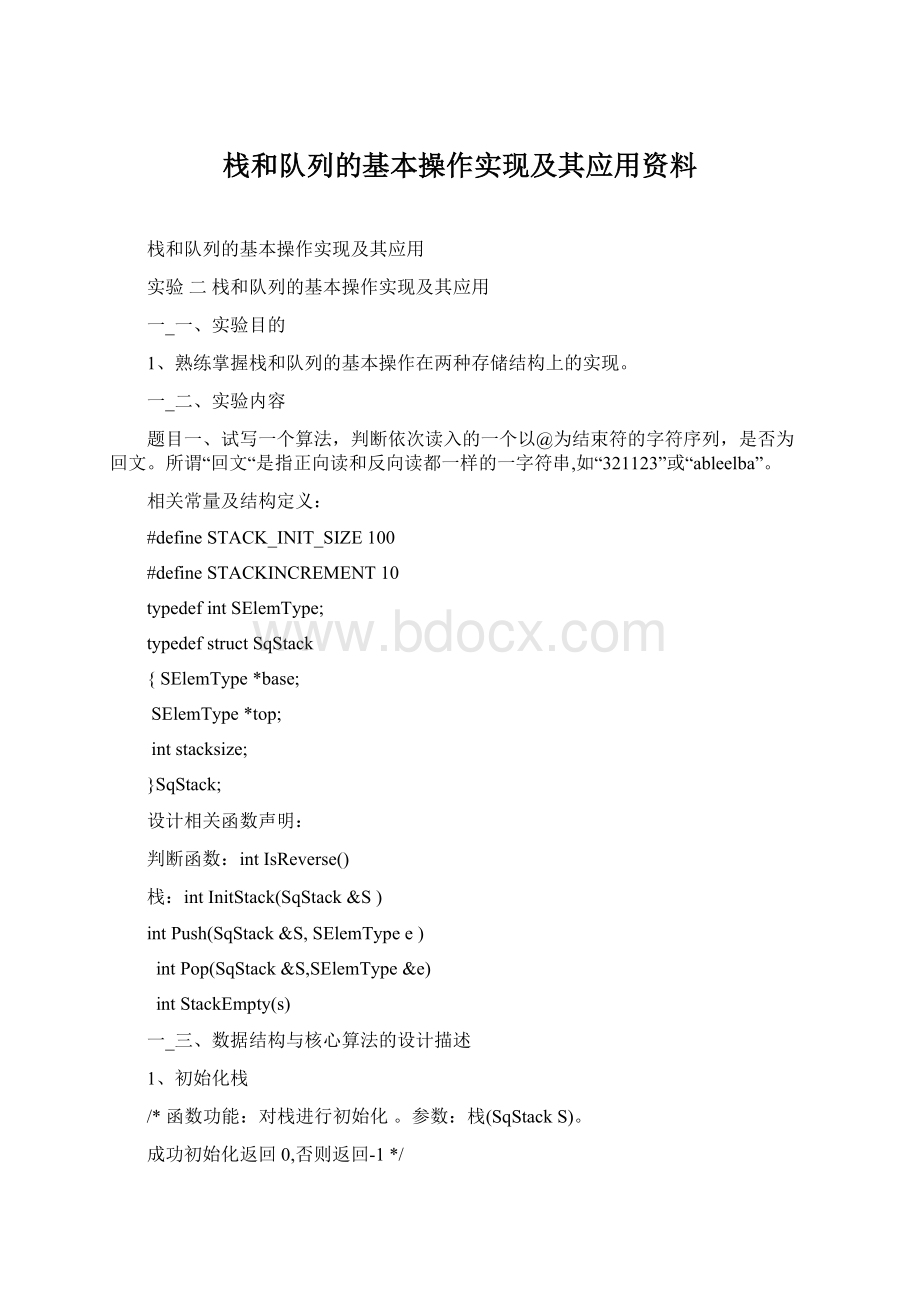栈和队列的基本操作实现及其应用资料Word格式文档下载.docx
《栈和队列的基本操作实现及其应用资料Word格式文档下载.docx》由会员分享,可在线阅读,更多相关《栈和队列的基本操作实现及其应用资料Word格式文档下载.docx(19页珍藏版)》请在冰豆网上搜索。

栈:
intInitStack(SqStack&
S)
intPush(SqStack&
S,SElemTypee)
intPop(SqStack&
S,SElemType&
e)
intStackEmpty(s)
一_三、数据结构与核心算法的设计描述
1、初始化栈
/*函数功能:
对栈进行初始化。
参数:
栈(SqStackS)。
成功初始化返回0,否则返回-1*/
S)
{
S.base=(SElemType*)malloc(10*sizeof(SElemType));
if(!
S.base)//判断有无申请到空间
return-1;
//没有申请到内存,参数失败返回-1
S.top=S.base;
S.stacksize=STACK_INIT_SIZE;
S.base=newSElemType;
return0;
}
2、判断栈是否是空
/*函数功能:
判断栈是否为空。
参数;
栈(SqStackS)。
栈为空时返回-1,不为空返回0*/
intStackEmpty(SqStackS)
if(S.top==S.base)return-1;
elsereturn0;
3、入栈
向栈中插入元素。
栈(SqStackS),元素(SElemtypee)。
成功插入返回0,否则返回-1*/
S,SElemTypee)
if(S.top-S.base>
=S.stacksize)
{
S.base=(SElemType*)realloc(S.base,(S.stacksize+1)*sizeof(SElemType));
//重新分配空间
if(!
S.base)return-1;
S.top=S.base+S.stacksize;
S.stacksize+=STACKINCREMENT;
}
*S.top++=e;
//插入操作
4、出栈
在栈中删除元素。
栈(SqStackS),元素(SElemtypee)。
成功删除返回0,否则返回-1*/
intPop(SqStack&
if(S.top==S.base)return-1;
e=*--S.top;
//删除操作
5、判断是否为回文
判断栈中的字符串是否为回文。
是回文时返回1,否则返回0*/
intIsReverse(SqStack&
inti;
chara;
for(i=0;
i<
j;
i++)
Pop(S,a);
if(a!
=b[i])return0;
return1;
一_四、函数的调用
主函数主要设计:
intlpp;
charch;
SqStackp;
InitStack(p);
cout<
<
"
请输入字符:
;
while((ch=cin.get())&
&
ch!
='
@'
)
Push(p,ch);
b[j]=ch;
j++;
if(StackEmpty(p)==-1)
{
cout<
此为空栈"
endl;
return0;
lpp=IsReverse(p);
if(lpp==0)cout<
此字符串不是回文。
elsecout<
此字符串是回文。
一_五、实验总结
通过这次试验我熟悉了对栈的基本操作,对基本的栈操作有了很好的掌握,知道自己容易在什么地方出错,。
一_六、程序清单
#include<
iostream>
usingnamespacestd;
charb[STACK_INIT_SIZE+STACKINCREMENT];
intj=0;
typedefcharSElemType;
S.base)return-1;
intmain()
intlpp;
二_一、实验目的
2、会用栈和队列解决简单的实际问题。
二_二、实验内容
题目二、编程模拟队列的管理,主要包括:
出队列、入队、统计队列的长度、查找队列某个元素e、及输出队列中元素。
typedefintQElemType;
typedefstructQNode
QElemTypedata;
structQNode*next;
}QNode,*QueuePtr;
typedefstruct
QueuePtrfront;
QueuePtrrear;
intcount;
}LinkQueue;
InitQueue(LinkQueue&
Q)
EnQueue(LinkQueue&
Q,QElemTypee)
DeQueue(LinkQueue&
Q,QElemType&
QueueLength(LinkQueueQ)
QueueTraverse(LinkQueueQ)
QueueFind(LinkQueueQ,QElemTypee)
二_三、数据结构与核心算法的设计描述
1、初始化队列
intInitQueue(LinkQueue&
Q.front=Q.rear=(QueuePtr)malloc(sizeof(QNode));
Q.front)return-1;
Q.front->
next=NULL;
2、入队列
intEnQueue(LinkQueue&
QueuePtrlpp;
lpp=(QueuePtr)malloc(sizeof(QNode));
lpp)return-1;
lpp->
data=e;
if(Q.front==NULL)
Q.front->
next=lpp;
Q.rear=lpp;
else
Q.rear->
3、出队列
intDeQueue(LinkQueue&
if(Q.front==Q.rear)return-1;
lpp=Q.front->
next;
e=lpp->
data;
next=lpp->
if(Q.rear==lpp)Q.rear=Q.front;
deletelpp;
4、统计队列的长度
intQueueLength(LinkQueueQ)
QueuePtrlpp=Q.front;
inti=0;
while(lpp!
=Q.rear)
i++;
lpp=lpp->
returni;
5、查找队列的某个元素
intQueueFind(LinkQueueQ,QElemTypee)
QueuePtrp;
p=Q.front->
while(p)
if(p->
data==e)
return1;
p=p->
6、遍历队列